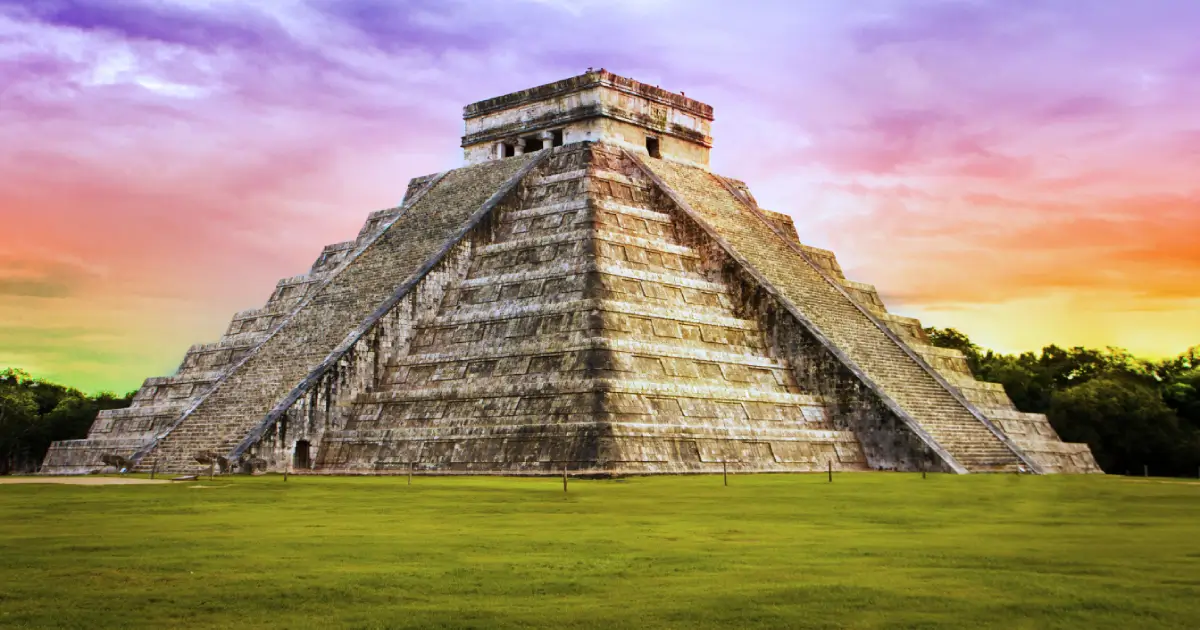Explore the Iconic Pyramids in Mexico – Travel Guide
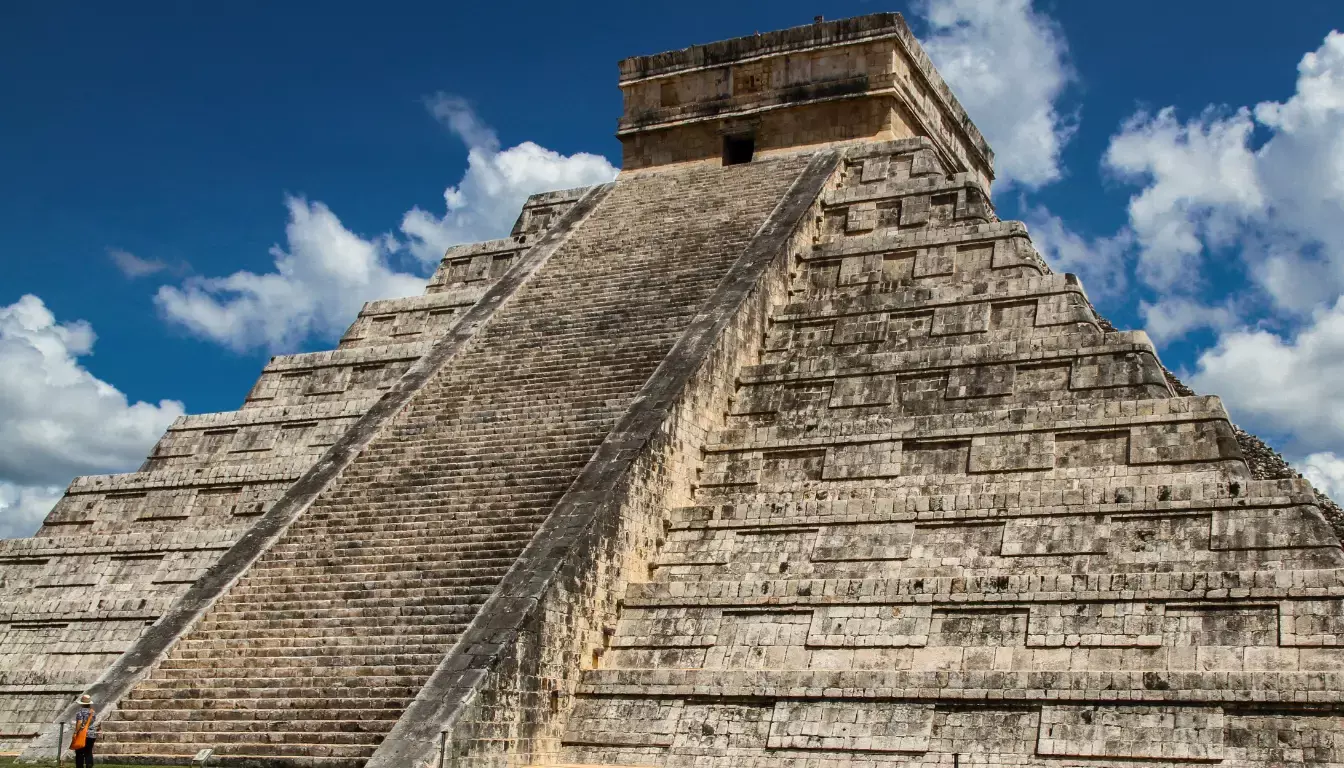
These tall monuments were more than just graves. They were built for spiritual ceremonies, watching the stars, and religious rituals. Each one has a story about the advanced societies that made them.
Visiting these mesoamerican pyramids is both educational and exciting. You can climb steep steps, find hidden temples in the jungle, and see stunning sunrises. From famous spots near cities to secret places in the forest, each place offers a special experience. It connects you to the ancient world.
Understanding the Magnificent Pyramids in Mexico
Mesoamerican Pyramid Construction Techniques
Ancient builders used remarkable engineering solutions to build these massive structures. They cut stones so precisely they fit together without mortar. They moved heavy limestone blocks using wooden rollers, ropes, and human power, as they had no wheeled vehicles.
The construction needed careful planning and math. Builders made complex drainage systems to avoid water damage. They also aligned their pyramids with celestial events like solstices and equinoxes.
Building layer by layer, civilizations could grow their pyramids over time. Many pyramids show signs of being built in phases over centuries. This method helped spread the weight evenly.
Ancient Civilizations Behind These Monuments
The Olmec civilization started pyramid building around 1200 BCE. They set the architectural foundation that later cultures improved upon. Their influence spread across Mesoamerica, inspiring future builders.
Maya engineers added math precision to architecture between 250-900 CE. They made detailed calendars and included complex astronomy in their designs. Their pyramids had steep staircases and detailed decorations.
The Aztec Empire built pyramids that were grand and large. They placed their structures in cities, blending them with plazas and homes. Zapotec builders chose strategic hilltop locations for their pyramids, giving them great views.
What Makes Mexican Pyramids Unique
Mexican pyramids are different from Egyptian ones in form and function. They have distinctive stepped designs with flat tops for temples or ceremonies. This design shows their role as religious and community centers.
These structures are unique because they were part of urban planning. They were built as key points in larger complexes with palaces, ball courts, and homes. This approach made them central ceremonial centers, not just tombs.
Most Mexican pyramids show signs of being built in phases. Civilizations often built new structures over old ones, creating layers of history. This shows the continuous sacred significance of these places over time.
The pyramids’ astronomical alignments show advanced scientific knowledge. Builders aligned their pyramids with solar and lunar events, creating natural calendars. These features highlight the ancient Mesoamericans’ deep understanding of the sky.
Chichen Itza: The Most Famous Mayan Pyramid Complex
Chichen Itza is a UNESCO World Heritage Site and a New Seven Wonder of the World. It’s in Mexico’s Yucatan Peninsula and draws over two million visitors each year. This place is a mix of Maya astronomy and architecture.
The site covers 740 acres and was built between 600 and 1200 CE. Mayan pyramids here show advanced engineering that amazes scientists today. Each building had a special role in Maya ceremonies and astronomy.
El Castillo and Its Astronomical Marvel
El Castillo, the main chichen itza pyramid, stands 98 feet tall. It has exactly 365 steps, matching the solar year in the Maya calendar.
During spring and autumn equinoxes, a shadow creates a serpent illusion. This shadow slithers down the northern staircase for 3 hours and 22 minutes. Thousands of visitors see this amazing sight twice a year.
Inside El Castillo, archaeologists found an earlier pyramid with a jade jaguar throne. The outer pyramid was built over this around 1000 CE. This shows Maya builders’ respect for the past while expanding their monuments.
Temple of Warriors and Great Ball Court
The Temple of Warriors has over 1,000 carved columns showing Maya warriors and nobles. Each column tells stories of conquest and ceremonies. The top platform offers stunning views of the complex.
Next to the temple is the Great Ball Court, the largest in Mesoamerica. It’s 554 feet long and 231 feet wide. The court’s design allows whispers to be heard 500 feet away.
Stone rings on the walls were the game’s goals. Players used their hips and shoulders to move a solid rubber ball. Winning or losing this game could mean life or death.
Planning Your Visit to This Wonder of the World
Visit Chichen Itza early morning or late afternoon to avoid crowds and heat. Gates open at 8 AM, and the first two hours are best for photos. Tickets include access to all structures except climbing El Castillo, which was banned in 2006.
The evening light and sound show make the ruins magical. Colorful projections light up the pyramids while telling Maya stories. Shows run Tuesday through Sunday at 7 PM in winter and 8 PM in summer.
Wear comfortable shoes, bring sun protection, and lots of water. Exploring the site takes 3-4 hours. Professional guides share insights into Maya culture and astronomy.
Teotihuacan: Pyramids of the Sun and Moon
Teotihuacan is just 30 miles northeast of Mexico City. It’s an ancient city that takes you back to Mesoamerica’s greatest times. Here, you’ll see some of the most amazing Teotihuacan pyramids ever. It was once home to over 100,000 people, bigger than many European cities back then.
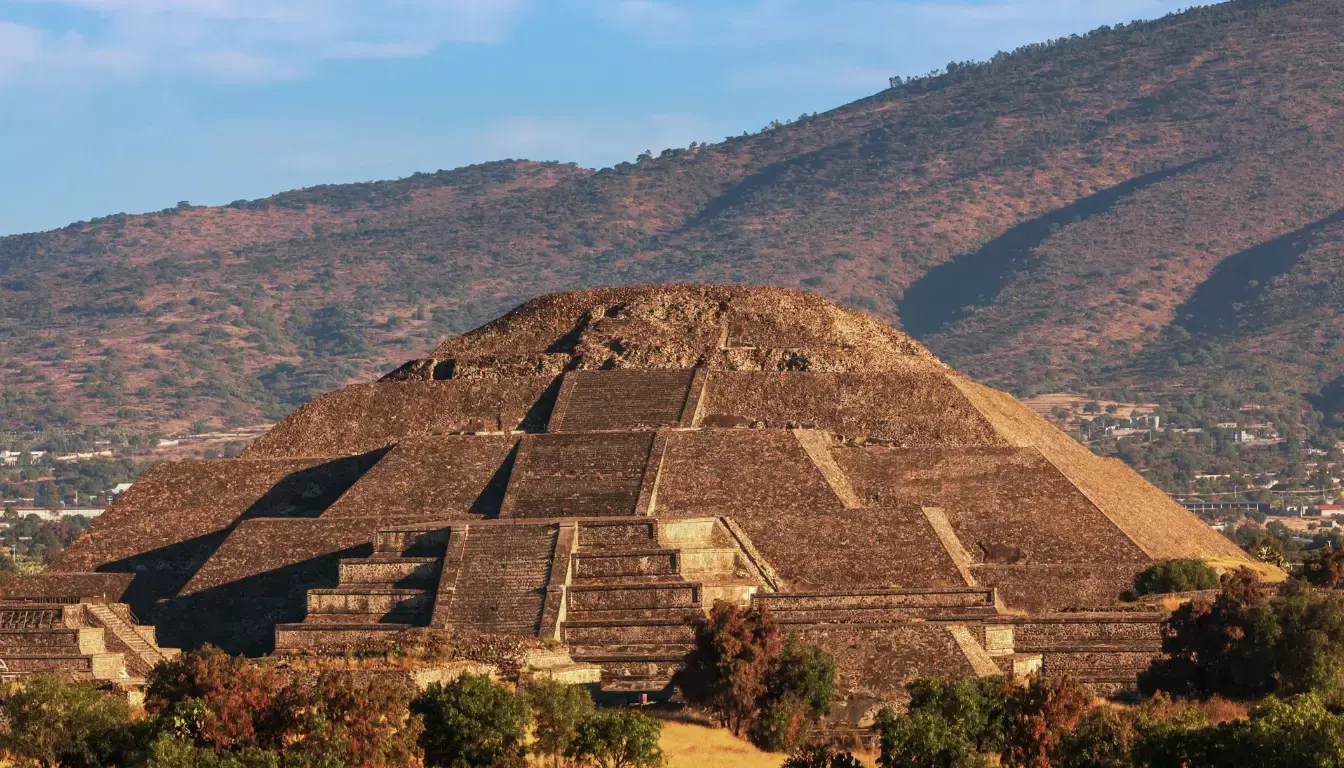
Walking through Teotihuacan feels like stepping into a huge city from history. The pyramids here are as big and well-made as Egypt’s famous ones. But, these pyramids were built long before the Aztecs came along.
Mexico’s Largest Ancient Structure
The Pyramid of the Sun is a giant, standing 216 feet tall and covering 5.4 acres. It’s the third-largest pyramid in the world and the biggest ancient structure in Mexico. Climbing to the top is tough, but the views are stunning.
This huge pyramid is made of over 1.1 million cubic yards of stone and earth. It’s built to face west, aligning with the sun on special dates. This was important for ancient ceremonies.
Visiting early in the morning is best. The cool air and golden light make for amazing photos. Shadows play beautifully on the pyramid’s terraces.
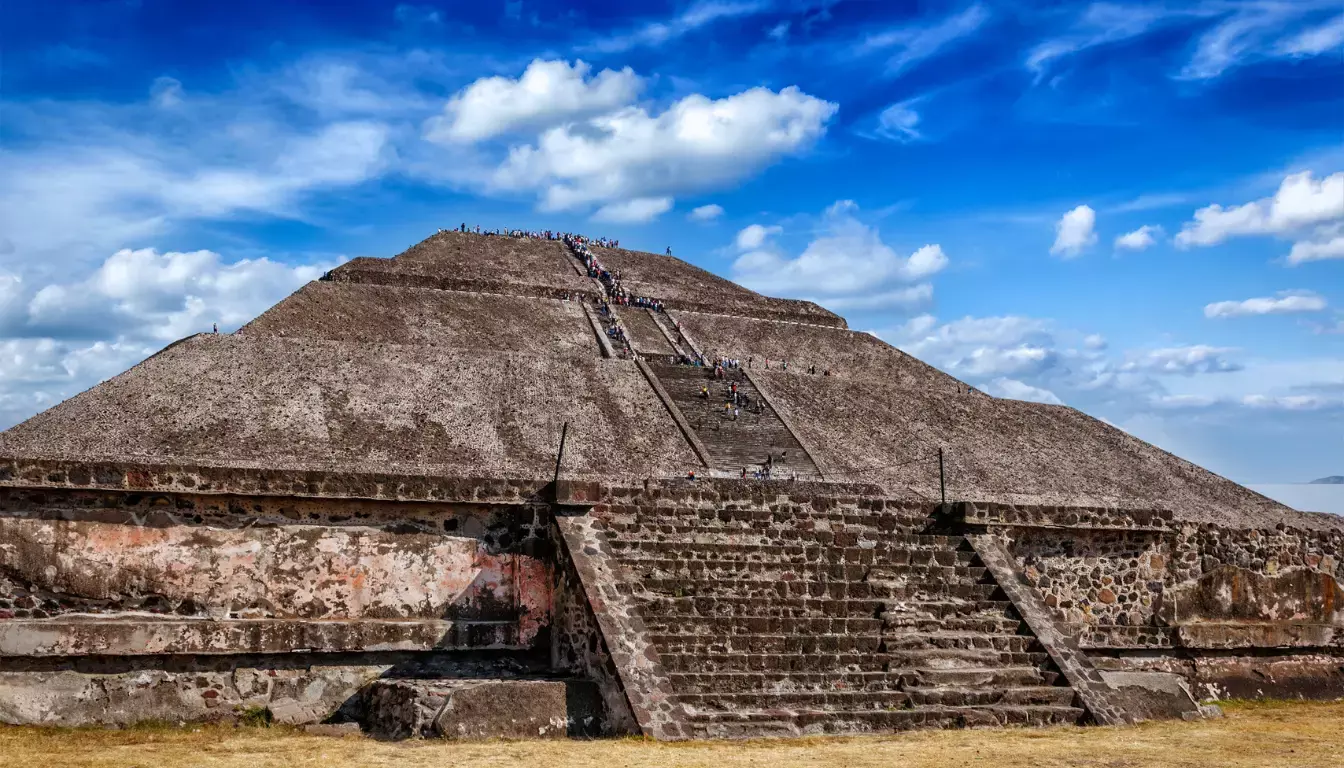
Avenue of the Dead and Ceremonial Pathway
The Avenue of the Dead is a 1.5-mile path that connects the pyramids. It leads to the Pyramid of the Moon, 140 feet tall. The Aztecs named it the Avenue of the Dead when they found it.
The Pyramid of the Moon offers spectacular panoramic views from the top. The Avenue of the Dead runs straight through the site, creating a north-south axis. The pyramid’s design mirrors the nearby Cerro Gordo mountain.
Underground Tunnels and Modern Discoveries
Recent finds have shown tunnels under the Pyramid of the Sun. Archaeologists found liquid mercury, which they think is an underworld river. These tunnels were filled with jade, obsidian, and shells.
Ground-penetrating radar has found more sealed chambers. Scientists are making groundbreaking discoveries that change how we see this ancient civilization. These new findings show the pyramids had more uses than just for ceremonies.
Palenque: Maya Jungle Pyramids in Chiapas
The dense tropical rainforest of Chiapas hides Palenque, where Maya pyramids rise from the jungle. This UNESCO World Heritage site is one of Mexico’s most atmospheric archaeological spots. Morning mist and howler monkeys announce dawn across ancient temples.
Palenque is known for its mix of ancient mexican civilizations and natural beauty. The site shows off Maya engineering in a wildlife-rich ecosystem. Waterfalls play music as you explore pyramids and palaces.

Temple of Inscriptions and Pakal’s Royal Tomb
The Temple of Inscriptions is Palenque’s highlight. It houses the tomb of Pakal the Great, who ruled for 68 years. The temple’s walls are covered in hieroglyphics telling of Maya history and royal lines.
Pakal’s tomb is deep within the pyramid, found in 1952. The jade mask and sarcophagus show Maya artistry. Royal burial practices are revealed through these artifacts and symbols.
The temple’s design shows Maya knowledge of astronomy and math. Each part serves spiritual and practical purposes, honoring earthly power and cosmic beliefs.
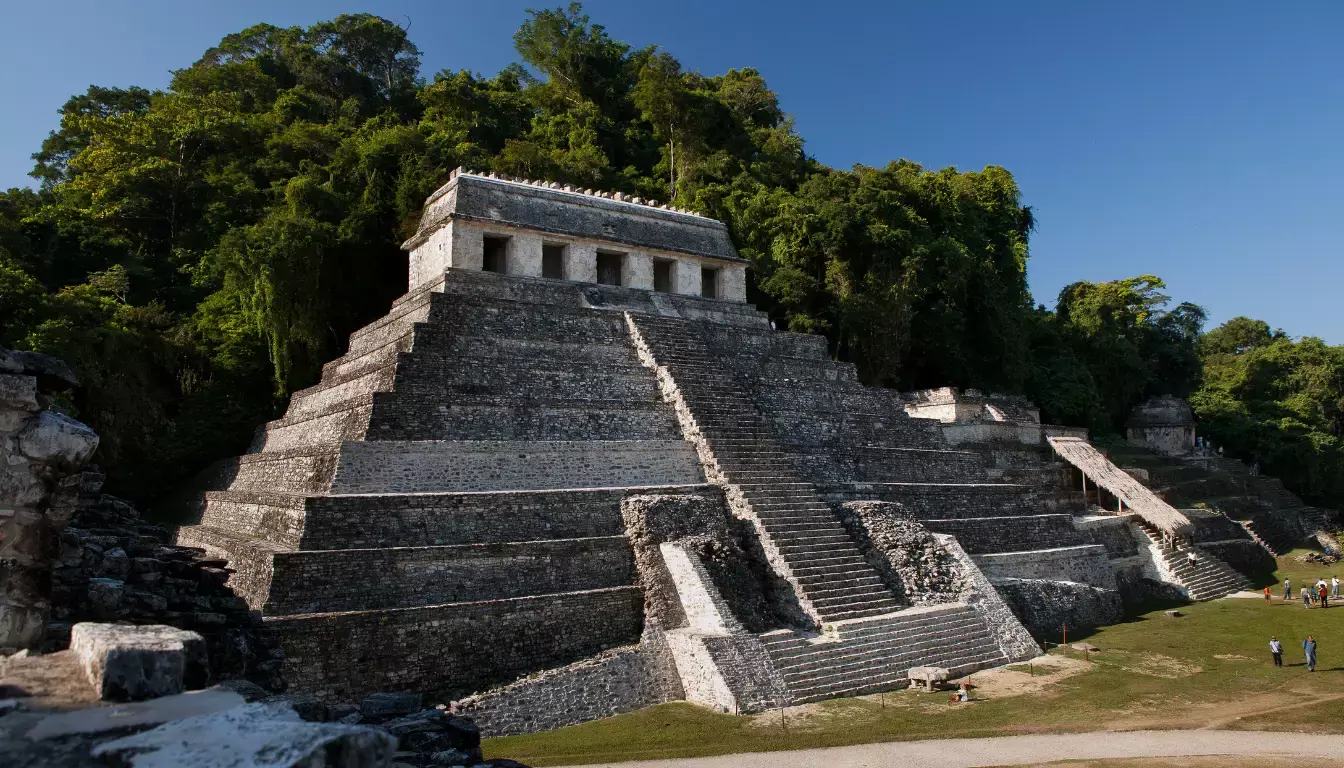
Palace Complex and Cross Group Architecture
The Palace complex shows Maya architectural growth. It has a four-story tower and detailed sculptures. This was the center of royal ceremonies and government.
The Cross Group temples show Maya building skills and symbolism. These pyramids represent Maya cosmology. Architectural innovations include corbelled arches and stone carvings.
Relief panels depict royal ceremonies and myths. The craftsmanship shows Maya art and devotion. These monuments last forever.
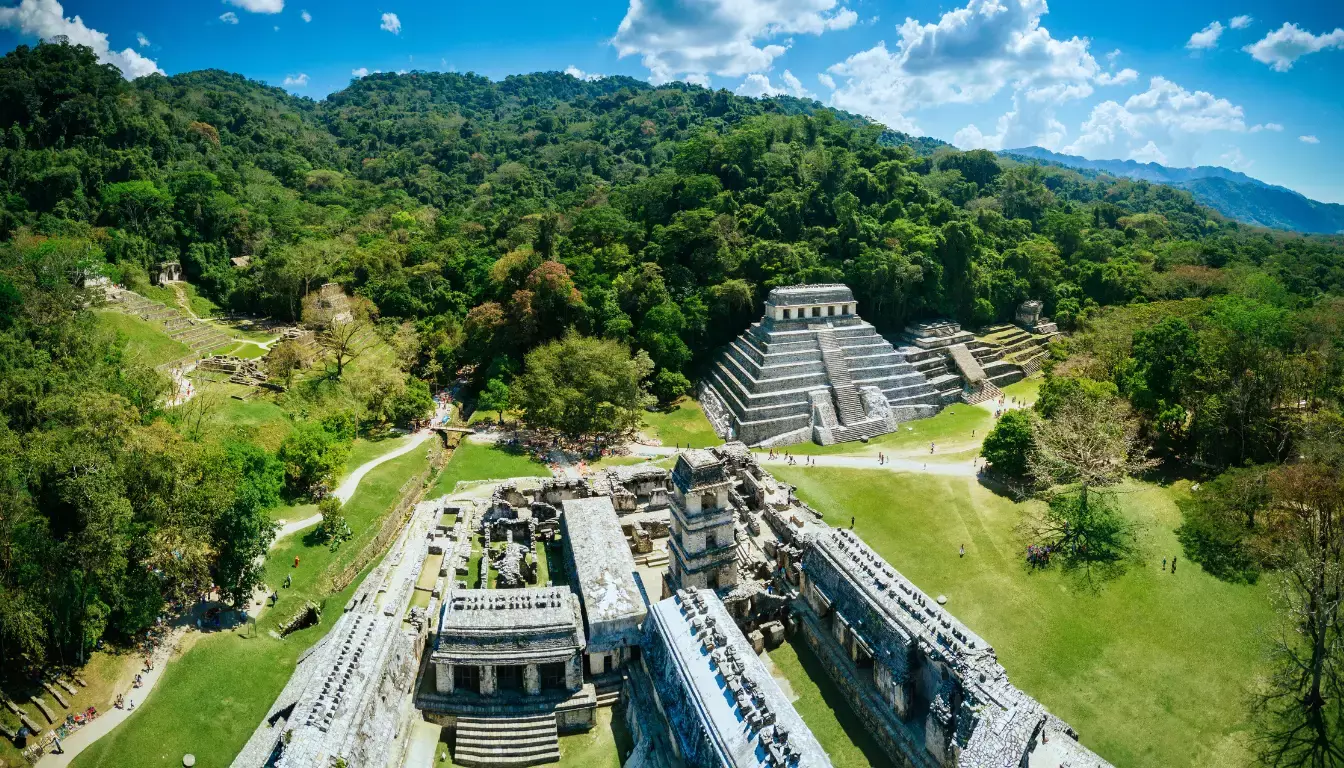
Exploring the Rainforest Archaeological Site
Palenque offers wildlife viewing and archaeology. Howler monkeys and birds create a natural symphony. The jungle setting is perfect for photos.
Trails connect major structures, allowing you to feel the site’s mystique. Pyramids are partially covered in vegetation, blending nature and human achievement. You can see cecropia trees and strangler figs.
The site’s waterfalls add to its charm. Adventure seekers love the mix of culture and nature. Palenque is unique among Mexican sites.
Plan a full day to explore Palenque. Early morning is best for wildlife and photos. The jungle provides shade, even in warm months.
Uxmal: The Pyramid of the Magician
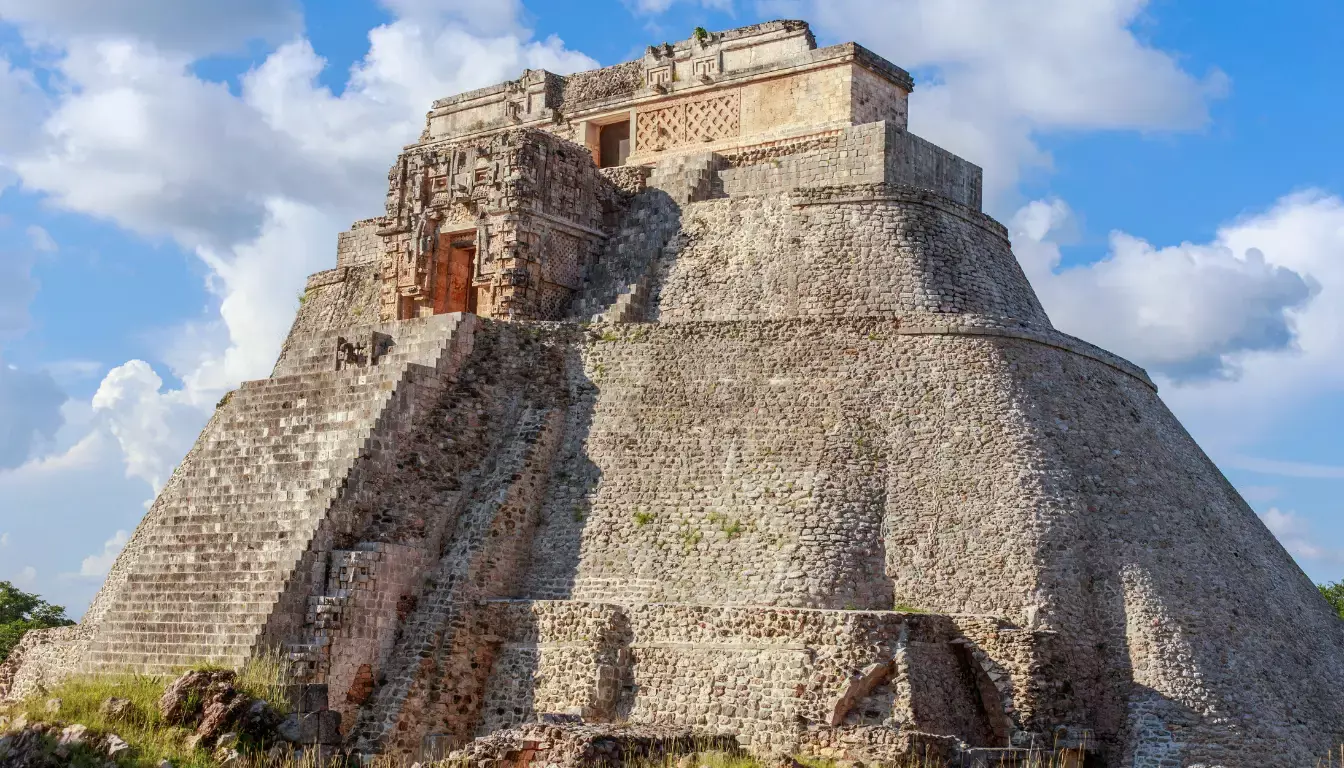
Uxmal rises from the Yucatan jungle, home to the Pyramid of the Magician with its unique oval base. This site is one of the finest examples of mayan pyramids in Mexico. The ancient city thrived from 600 to 900 CE, leaving behind architectural wonders that amaze visitors today.
Uxmal’s location in the Puuc Hills was perfect for the Maya’s grand constructions. The site’s name means “thrice built,” showing its multiple construction phases. Unlike other pyramid sites, Uxmal is well-preserved, allowing visitors to see the Maya’s craftsmanship up close.
Unique Oval-Shaped Pyramid Design
The Pyramid of the Magician in Uxmal stands out with its steep 115-foot height and unique oval base. Legend claims a dwarf magician built it overnight, but archaeology shows it was built in five phases over centuries. Its eastern staircase features Chaac masks, while the west leads to a serpent-shaped temple doorway.
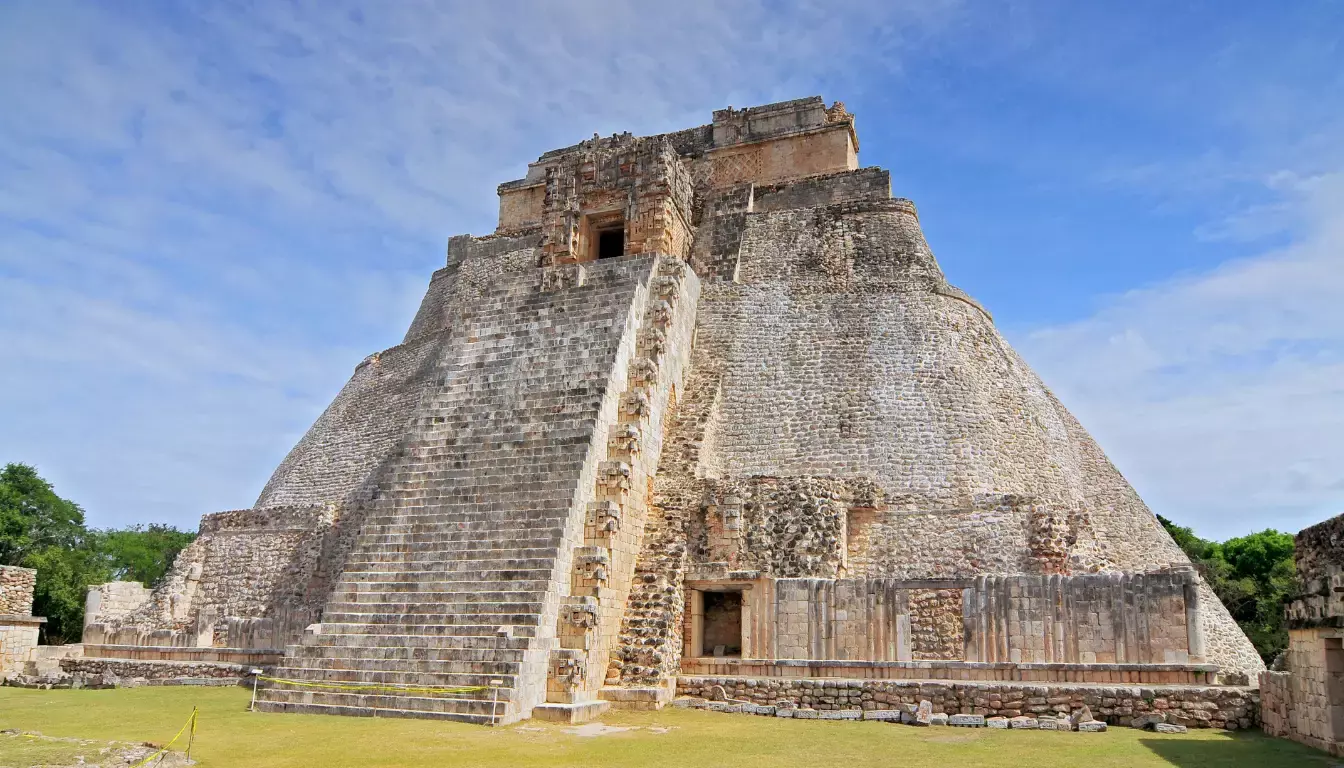
Governor’s Palace and Puuc Architectural Style
The Governor’s Palace is a masterpiece of the Puuc architectural style at Uxmal. It stretches 320 feet long and sits atop a massive artificial platform. The facade displays over 20,000 individually cut stones in geometric patterns, creating stunning visual effects.
Puuc architecture is known for its horizontal lines, mosaics, and precise astronomical alignments. The Governor’s Palace shows these principles with its proportions and decorations. The central doorway aligns with Venus at its southernmost position, showing the Maya’s advanced knowledge of astronomy.
At Uxmal, you’ll find sophisticated water management systems. The Maya built elaborate cisterns and channels to collect rainwater. These innovations supported a thriving population in an area with no natural water sources, highlighting the ingenuity of these mayan pyramids and their complexes.
Evening Sound and Light Spectacular
At night, Uxmal turns into a magical wonderland with its colorful sound and light show. As the sun sets, projections light up the ancient ruins while narration brings Maya legends to life. The 45-minute show runs every evening (weather permitting) and is a must-see experience.
Plan to visit the site in the afternoon to explore landmarks like the Pyramid of the Magician, then stay for the show. It’s the perfect way to end your day and connect with Maya culture on a deeper level.
Tickets for the show are sold separately. You can bring a cushion or rent a chair—seating is on stone steps and the show lasts about an hour.
El Tajin: The Pyramid of the Niches in Veracruz
The ancient city of El Tajin is home to the Pyramid of the Niches, a marvel of Mesoamerica. Located in Veracruz, it showcases the Totonac civilization’s engineering prowess. The el tajin pyramids blend math and religion, making them unique in Mexico.
El Tajin thrived from 600 to 1200 CE as a major center for ceremonies and trade. It boasts over 20 structures, but the Pyramid of the Niches stands out. This seven-tiered wonder shows the Totonacs’ skill in architecture and astronomy.
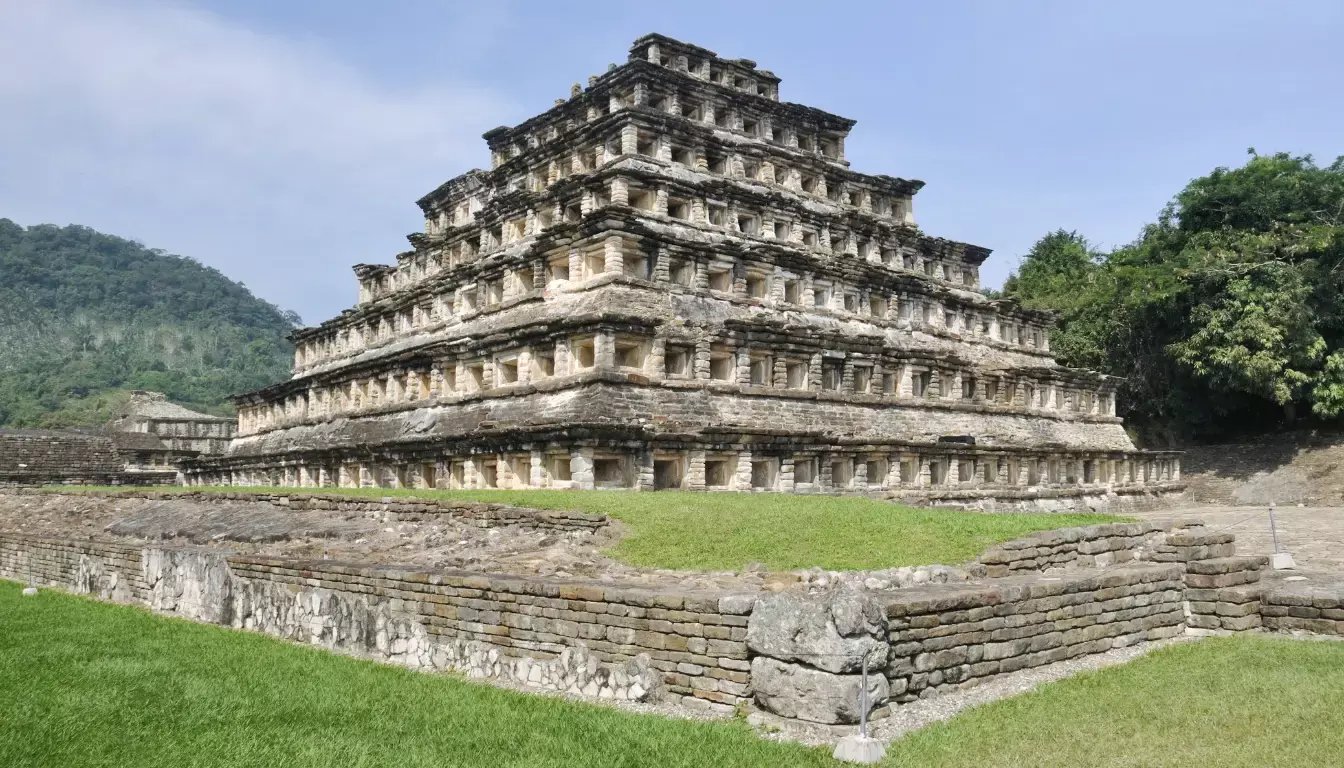
365 Niches Representing the Solar Calendar
The Pyramid of the Niches is famous for its 365 square recesses. Each niche represents a day of the solar year, making it a massive calendar. The changing light and shadow highlight its beauty.
The el tajin pyramids show impressive math skills. The pyramid is 60 feet high with seven levels. Each level has niches that add up to 365, matching the solar year.
Visitors see the sun’s shadows change in the niches. This shows the Totonacs built it as a timepiece and a religious symbol.
Totonac Civilization and Ball Game Rituals
The Totonacs, who built the el tajin pyramids, were skilled athletes and ritualists. El Tajin has 17 ball courts, more than any other site. The ball game was key in Totonac society.
Relief sculptures show ball game scenes. The South Ball Court has detailed carvings of players, sacrifices, and myths. These stories tell of cosmic battles.
The ball game had many roles in Totonac culture:
- Religious ceremonies honoring the gods
- Political negotiations between rival groups
- Athletic competitions showing physical prowess
- Ritual reenactments of creation myths
UNESCO World Heritage Site Features
UNESCO named El Tajin a World Heritage Site in 1992. It recognized its outstanding universal value. The el tajin pyramids show innovative architecture that influenced later Mesoamerica.
The site’s UNESCO status protects its features. The Pyramid of the Niches has advanced engineering. The Building of the Columns shows detailed relief work of Totonac rulers and deities.
Recent research has shed new light on El Tajin’s trade networks. You can see ongoing excavations. The tropical setting adds to its significance, as few sites are in such environments.
Coba: Climb the Tallest Pyramid in Yucatan
Deep in Yucatan’s jungle lies Coba, home to the tallest climbable pyramid in Mexico. This ancient Maya city offers a rare adventure experience unlike other mexican archaeological sites. You can climb to the top of towering stone structures here.
Coba spreads across a vast area connected by ancient roads. The site sits between several natural lakes that once made it a powerful trading center. Today, dense jungle surrounds these impressive ruins.
Nohoch Mul – The 138-Foot Climbable Pyramid
Nohoch Mul towers 138 feet above the jungle canopy, making it the tallest pyramid in Yucatan Peninsula. You can climb all 120 stone steps to reach the summit. The steep ascent requires careful footing and steady nerves.
At the top, you’ll enjoy breathtaking 360-degree views of endless green forest. The jungle stretches to the horizon in every direction. This spectacular vista rewards your challenging climb.
Most other Maya pyramids now restrict climbing access. Coba remains one of the few places where you can experience this authentic adventure. Bring sturdy shoes with good grip for safety.
Jungle Bicycle Tours Through Ancient Roads
Coba’s extensive network of ancient Maya roads called sacbeob connects different pyramid groups. These white stone pathways once linked important ceremonial areas. You can rent bicycles at the entrance to explore efficiently.
Cycling through the jungle lets you cover more ground than walking. The site spans several miles with multiple pyramid clusters. Bikes help you reach remote areas while enjoying the natural setting.
Paved paths wind through towering trees and tropical vegetation. You’ll spot colorful birds and hear howler monkeys calling from the canopy. The bicycle tour combines archaeology with wildlife observation.
Start Planning Your Mexican Journey Today
Find the perfect accommodations, tours, and experiences for your trip to Mexico’s most beautiful cities.
Book You FlightSacred Cenotes and Wildlife Encounters
Several sacred cenotes dot the Coba area, where ancient Maya conducted important ceremonies. These natural sinkholes contain crystal-clear fresh water. You can swim in some cenotes after exploring the ruins.
The jungle habitat supports diverse wildlife species. Spider monkeys swing through the trees above the pyramids. Tropical birds like toucans and parrots add splashes of color to your visit.
Butterflies flutter along the forest paths in amazing variety. Early morning visits offer the best wildlife viewing opportunities. The cooler temperatures also make pyramid climbing more comfortable.
Plan to spend a full day at Coba for the complete experience. Bring plenty of water and sun protection for your jungle adventure. The combination of climbing, cycling, and swimming creates an unforgettable archaeological journey.
Monte Alban: Zapotec Pyramids Above Oaxaca Valley
Monte Alban rises above Oaxaca Valley, showing off pre-columbian architecture that has amazed people for centuries. This Zapotec capital is 1,300 feet up on a flat mountaintop. It controlled three valleys and was a ceremonial center for over 1,000 years.
Monte Alban is a masterpiece of urban planning from 500 BCE to 800 CE. Its hilltop location helped the Zapotec control trade and politics. Today, it’s one of Mexico’s most stunning archaeological sites.
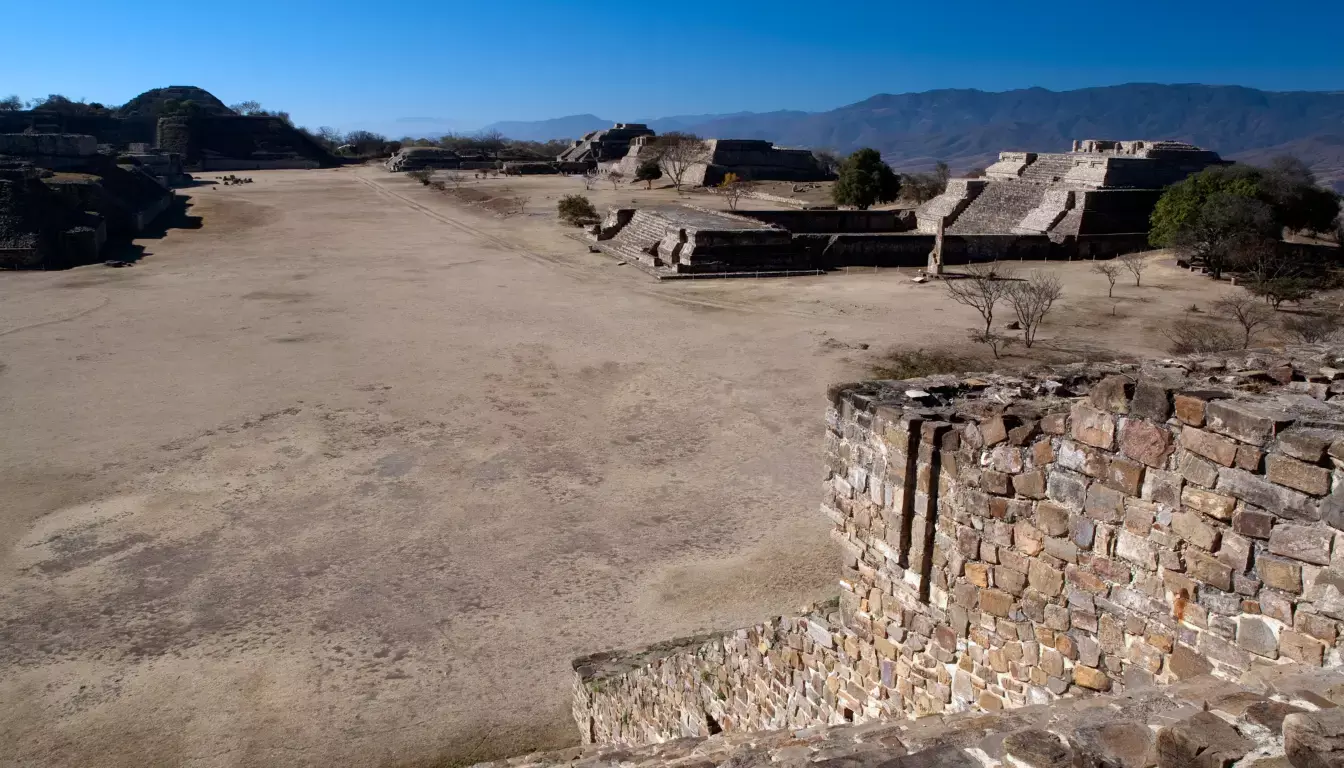
Grand Plaza and Ceremonial Platforms
The Grand Plaza at Monte Alban is huge, measuring 300 by 200 meters. Ancient engineers leveled it by movin earth and stone. Walking here, you step on the ground where Zapotec rulers held rituals.
Around the plaza, pyramids, palaces, and platforms show off the Zapotec’s architectural skills. You’ll see:
Building J – An arrow-shaped observatory aligned with celestial events
South Platform – A massive pyramid complex with multiple levels
North Platform – The highest structure with valley views
Ball Court – Where ritual games connected earthly and divine realms
Danzantes Stones and Ancient Inscriptions
The Danzantes stones are mysterious, with carved figures that have puzzled archaeologists for years. These stones might show captives, rulers, or astronomical symbols. The carvings give insights into Zapotec writing and culture.
The inscriptions are part of Mesoamerica’s earliest writing systems. You’ll see hieroglyphic symbols that record dates, names, and events. Many stones show figures in dynamic poses, earning them the “dancers” nickname.
Spectacular Valley Views and Sunset Photography
Monte Alban offers some of Mexico’s most stunning views. You’ll see the Oaxaca Valley with its fields and mountains. The high position is perfect for photography all day.
Sunset is magical for photography, with golden light on ancient stones. Arrive an hour before sunset for the best spots. The dramatic light and ancient architecture make unforgettable images.
Wear comfortable shoes for exploring the site. The steep road requires careful driving, but the views are worth it. Early morning and late afternoon are best for light and photography.
Hidden Gems: Lesser-Known Mexican Pyramid Sites
There are amazing archaeological sites in Mexico that are not as well-known. These mesoamerican pyramids let you see ancient civilizations up close. You’ll feel like you have the place to yourself, away from the crowds.
These sites show off different architectural styles and cultural influences. Each one has its own story of ancient people who shaped Mexico. Visiting these places gives you real experiences and amazing discoveries.
Xochicalco’s Feathered Serpent Pyramid
Xochicalco is a UNESCO World Heritage site known for its unique mesoamerican pyramids. The Feathered Serpent Pyramid has stunning stone carvings. It shows the mix of Maya, Zapotec, and Central Mexican styles.
Carved serpents, seated figures, and glyphs show the wide trade networks of ancient Mexico. The site’s high spot gives breathtaking views of valleys below. It was a major commercial center from 650 to 900 CE.
The pyramid is about 65 feet on each side. Its carvings tell of political alliances and cultural exchange. You can see the observatory, ball courts, and homes that show life in this ancient city.
La Venta’s Olmec Ceremonial Complex
La Venta in Tabasco is Mexico’s oldest monumental architecture, from 900 BCE. It was the start of all mesoamerican pyramids and ceremonial sites. The huge earthen pyramid stands 100 feet tall above wetlands.
The famous colossal basalt heads weigh up to 20 tons. They show the artistic mastery of the Olmecs. The site also has altars, stelae, and buried offerings that show complex religious practices.
The pyramid’s design influenced later architecture in Mexico. A nearby museum has artifacts from excavations. The Olmecs’ innovations in art, writing, and calendars influenced all future Mesoamerican cultures.
Cacaxtla’s Colorful Mural-Covered Structures
Cacaxtla is home to Mexico’s most stunning pre-Columbian murals. These mesoamerican pyramids have vibrant paintings from 600 to 900 CE. The murals are well-preserved thanks to archaeologists’ protective work.
The paintings show scenes of warfare, trade, and ceremonies. They feature warriors, merchants, and nobles in brilliant blues, reds, and yellows. These artworks give insights into ancient life and social structures.
The Battle Mural is over 70 feet long and depicts conflicts between groups. You can see Maya-style clothing and Central Mexican influences. The site’s high spot offers panoramic views of the Tlaxcala valley
Mitla’s Geometric Mosaic Architecture
Mitla is the peak of Zapotec architecture, with its mesoamerican pyramids and palace structures. The site has stone mosaics made without mortar, showing engineering skills. These geometric patterns show the Zapotec’s cosmology and beliefs.
There are five main groups of buildings with over 14 mosaic patterns. Each pattern has symbolic meaning. The Hall of Columns has massive pillars supporting decorated roofs.
Mitla was a religious center and royal residence for Zapotec nobility. You can see underground chambers believed to be underworld entrances. Its name, “place of the dead” in Nahuatl, shows its sacred importance.
These hidden sites offer real experiences with mesoamerican pyramids away from tourist spots. You’ll see different architectural styles, artistic achievements, and cultural innovations that shaped ancient Mexico. Each place invites personal reflection and deeper understanding of pre-Columbian civilizations.
Conclusion
Mexico’s pyramids offer a window into the brilliance of ancient civilizations—masters of astronomy, engineering, and storytelling in stone. From Chichen Itza’s celestial shadows to Palenque’s mystical jungle setting, each site reveals a unique piece of history.
Plan your visit by region and season—Yucatán’s dry months are ideal for Chichen Itza, Uxmal, and nearby Coba, while Chiapas’ rainforest sites need extra prep. Respect site rules, support local artisans, and consider hiring guides to hear stories passed down for generations.
Your visit helps preserve these wonders and uplift local communities. Share your experience—be a voice for cultural preservation.
FAQ
How many pyramids are there in Mexico?
Mexico boasts over 47,000 archaeological sites. Among these, hundreds of pyramids stand out. Famous ones include Chichen Itza, Teotihuacan, Palenque, Uxmal, and more. These pyramids show the ancient Mexican civilizations’ architectural prowess.
Which Mexican pyramid is the largest?
The Pyramid of the Sun at Teotihuacan is the largest in Mexico. It reaches 216 feet tall and spans 5.4 acres. It’s the third-largest pyramid globally, a testament to pre-columbian architecture.
Can you stil climb pyramids in Mexico?
Yes, but access varies by site. You can climb Nohoch Mul at Coba, the tallest climbable pyramid in Yucatan. Some Teotihuacan structures also allow climbing. But, climbing is banned at Chichen Itza to protect the structures.
What’s the difference between Mayan and Aztec pyramids?
Mayan pyramids have steep sides, detailed carvings, and align with the stars. They’re found in jungles like Palenque and Uxmal. Aztec pyramids, like those at Teotihuacan, are bigger with broader bases. They were part of large cities.
When is the best time to visit Mexican pyramids?
Visit from November to April for the dry season. Go in the early morning or late afternoon to avoid crowds and heat. The equinox shadow effect at Chichen Itza in March and September is a highlight.
How were Mexican pyramids constructed without modern tools?
Ancient civilizations used advanced techniques. They cut stones precisely, built drainage systems, and aligned structures with the stars. Thousands of workers moved massive stones without wheels or metal tools.
Can I take day trips from Monterrey?
Yes, there are great day trip options. You can visit the Magical Town of Santiago, explore Villa de García, or see attractions near Monterrey Airport.
Is Baja California Sur safe for tourists?
Generally, Baja California Sur is safe for tourists. Always take precautions to stay safe, like being aware of your surroundings and keeping valuables secure.
Are there pyramids in Mexico City?
Mexico City has Aztec temple foundations like Templo Mayor. But, the closest major pyramid complex is Teotihuacan, 30 miles northeast. It’s a great day trip from the capital.
Start Planning Your Mexican Journey Today
Find the perfect accommodations, tours, and experiences for your trip to Mexico’s most beautiful cities.
Book Your AccommodationsBrowse Flights to Mexico
